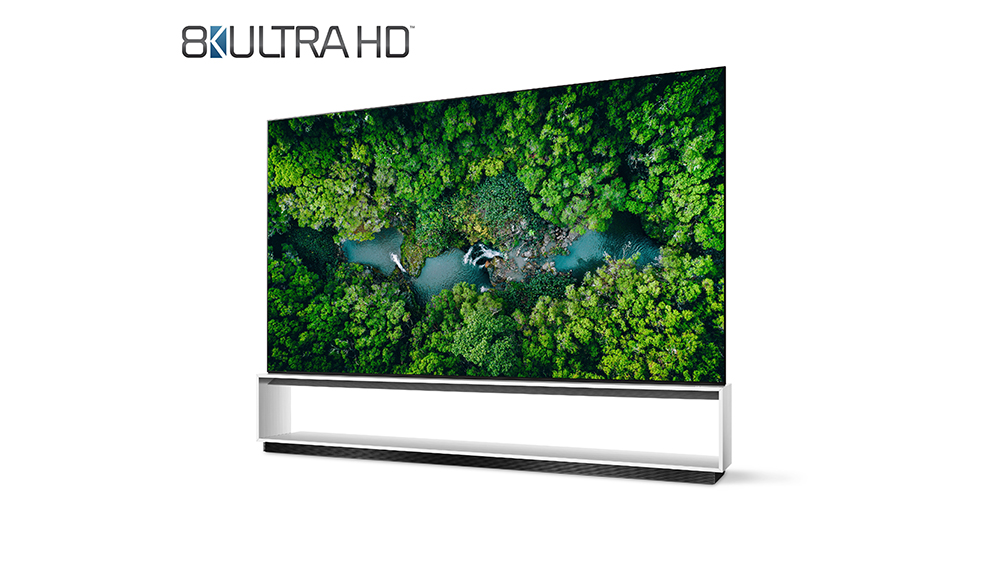LG 'Real 8K TVs' for 2020 are first to receive industry’s 8K certification
They will make their debut at CES 2020 next month

In September, the Consumer Technology Association (CTA) revealed the official industry definition and logo for 8K TVs – and despite Samsung being the TV manufacturer making most of the 8K noise so far, it is LG’s 8K TVs that will be industry-certified first.
LG has announced that every LG 8K TV, including the ‘Real 8K TVs’ it will debut at CES 2020 next month, will bear the 8K UHD logo. That means they meet the set of performance criteria, having, for example, at least 33 million active pixels, a bit depth of 10-bits and the ability to upscale SD, HD and 4K content.
The company says its TVs "exceed" the minimum requirements, too. For example, while the CTA states that 8K TVs must meet a 50 per cent minimum contrast modulation (i.e at least half of their pixels must be distinguishable to the naked eye) threshold to qualify, LG claims its SIGNATURE OLED 8K and 8K NanoCell TV delivers contrast modulation values in the 90 per cent range, 'while some other models in the industry remain in the low double digits'. According to two third-party testing firms, Intertek and Verband Deutscher Elektrotechniker, the company’s existing 75-inch NanoCell 8K TV measures 90 per cent contrast modulation horizontally and 91 per cent contrast modulation vertically.
But while the CTA’s standard is designed to help consumers recognise the gear that meets the industry’s requirements, note that a separate body called the 8K Association – agreed by the likes of Samsung, Hisense, Panasonic, TCL, Intel and Tencent – also has its own set of 8K TV parameters which doesn’t include minimum contrast modulation values. Meeting (and exceeding) the CTA's specs and wearing the badge can only be considered a win for LG, but with other standards being backed by different companies we wouldn't necessarily take it as definitive.
MORE:
CES 2020 preview: what to expect from the world's biggest tech show
LG 2019 TVs: 8K, 4K, OLED, LCD – everything you need to know
Get the What Hi-Fi? Newsletter
The latest hi-fi, home cinema and tech news, reviews, buying advice and deals, direct to your inbox.
Becky is the managing editor of What Hi-Fi? and, since her recent move to Melbourne, also the editor of the brand's sister magazines Down Under – Australian Hi-Fi and Audio Esoterica. During her 11+ years in the hi-fi industry, she has reviewed all manner of audio gear, from budget amplifiers to high-end speakers, and particularly specialises in headphones and head-fi devices. In her spare time, Becky can often be found running, watching Liverpool FC and horror movies, and hunting for gluten-free cake.
-
Reply
Apparently there will be an 65-inch 8k model from LG which will be an OLed TV too. I think might have separate firmware boxes too for 8K if I can remember right too from what I was reading from the AVF.What Hi-Fi? said:They will make their debut at CES 2020 next month, wearing the 8K Ultra HD logo loud and proud.
LG 'Real 8K TVs' for 2020 are first to receive industry’s 8K certification : Read more -
Here is the firmware upgrade box details:Reply
https://www.forbes.com/sites/johnarcher/2019/12/17/lg-starts-shipping-8k-tv-upgrade-box/ -
Hey this one has come down in price a bit:Reply
https://petertyson.co.uk/lg-oled88z9pla-smart-oled-television -
Friesiansam Who, apart from a few early adopters with money, cares about 8K? We're years away from any worthwhile quantity of content and the TVs are ridiculously expensive. By the time there is enough to watch to make owning an 8K TV worthwhile, competition will have brought the prices down.Reply -
My next TV won’t be an LG 8K TV but one of these Samsung’s:Reply
tkLIBCq5RZoView: https://www.youtube.com/watch?v=tkLIBCq5RZo -
Reply
More here by WHF:gel said:My next TV won’t be an LG 8K TV but one of these Samsung’s:
tkLIBCq5RZoView: https://www.youtube.com/watch?v=tkLIBCq5RZo
https://www.whathifi.com/reviews/samsung-75in-micro-led-tv

